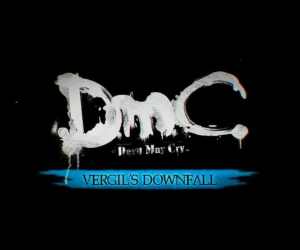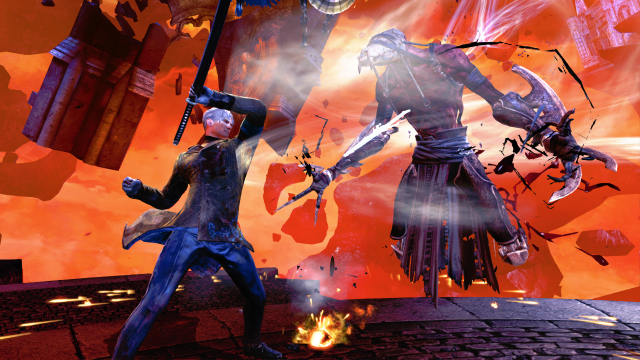 Game: DmC: Devil May Cry: Vergil’s Downfall DLC
Game: DmC: Devil May Cry: Vergil’s Downfall DLC
Developer: Ninja Theory
Publisher: Capcom
Available on: Xbox 360, PlayStation 3, Windows PC
Reviewed on: Xbox 360
We really enjoyed DmC: Devil May Cry here at GodisaGeek Towers, so we were all looking forward to finally getting our hands on the first piece of single-player DLC, Vergil’s Downfall. This story tells the tale of Vergil, Dante’s brother, immediately after he walks through the portal at the end of the game. This new DLC gives the player a new character to play with, some new weapons, some new skills and six whole stages to master them in. Is Vergil’s Downfall more of the same though? And would that even be a bad thing?
The story in Vergil’s Downfall follows immediately on from the end of the main DmC: Devil May Cry game. Vergil has been stabbed through the heart and is wandering around attempting to avoid death when he suddenly falls through the earth, landing in front of his childhood family home. As the title of the DLC would imply, this new content explores the character of Vergil as he falls from being the upstanding freedom fighter that he appears to be at the start of DmC down to the depths of humanity and beyond. It’s not long into the DLC when players will realise that this isn’t some simple, tacked-on bit of extra content; there’s a good chance that the events of Vergil’s Downfall will have major repercussions in the – highly-anticipated but as-yet non-existent – Ninja Theory-developed sequel to DmC: Devil May Cry.

The story in Vergil’s Downfall isn’t particularly well told, despite having something relatively interesting to say, and players that are only in it for the combat would probably happily skip over everything that’s being said. The voice acting isn’t too bad, it’s just that – perhaps in an intentional way, to reflect the ailments of the title character – the story has little to no heart.
The visuals in Vergil’s Downfall are exactly the same as they were in the main DmC game – they look excellent. Personally, I didn’t notice the texture-popping issue that was prevalent in DmC at all in Vergil’s Downfall. That could be because of the slight change in gameplay – which I’ll get to – which doesn’t give the player much free time to look at the environment, but I suspect that the solution has been to remove the cutscenes entirely from the game. The many cutscenes in DmC were the main offender when it came to the texture-popping, so the obvious solution would be to remove these from the game, which Ninja Theory has done. However, what they’ve replaced them with, motion comics, takes the player out of the immersion of the game much more than a couple of seconds of ugly textures ever would. The motion comics in Vergil’s Downfall don’t even look completed. I understand that the black and white style of the cutscenes is supposed to reflect the story but there’s no denying the fact that they simply look unfinished.
There are certain moments in the game, however, which are visually stunning. Towards the end of the DLC, on about the fourth stage, the player will be introduced to the level they’re about to enter by a sweeping camera shot that takes us all the way through the area. This is a very cinematic panning technique and is something that I would have much rather seen more of instead of the sub-par motion comics.
The voice-acting in Vergil’s Downfall is what everyone would probably expect from a piece of DLC that is meant to follow on from the main story. Vergil is the stand-out character from the point of view of the voice-acting, as you can truly hear his inner conflicts in the tiny nuances in his voice. When the gameplay ends and things really start to go nuts, there’ll be no doubt in anyone’s mind that Vergil has finally gone all the way.
The weapons sound effects in the game are also impressive, although the enemy sounds leave a lot to be desired. There aren’t many enemies to take on throughout the DLC, perhaps only four or five types – most of which we’ve also seen in the main game – but most people will get severely irritated by the exact same enemy damage sounds after only the second level. Vergil, or any of the other characters you meet, don’t do much talking during the levels themselves, so players shouldn’t be afraid to mute the TV or stick on a podcast – as long as it’s the GodCast – to get away from the repetitive sound effects.

The gameplay in Vergil’s Downfall is very similar to that in DmC: Devil May Cry. Essentially you’ll be given three basic moves with which to take down all of the enemies that happen to come your way. You’ll be given a light, fast attack, a heavy, slower attack and the ranged attack which, in Dante’s case, were his twin pistols Ebony and Ivory, but in Vergil’s story utilise his sword illusions. Throughout the game you’ll be awarded experience for killing enemies, and this experience goes towards awarding the player with a skill point. Each of these skill points can be used at pre-set intervals throughout each of the levels, or at the start, to upgrade certain attacks or buy new ones. These differing attack patterns, usually taking the form of combos but sometimes involving entirely new move-sets, are the crux of the DmC gameplay, and mastering them is the key to those elusive ‘SSS’ rankings that you’ll be hoping to attain at the end of each level.
One difference to note between Vergil and Dante is that Vergil’s combat is a lot more difficult to master. The timing of the moves is totally different to the equivalent moves of his brother, so even players that have put a massive amount of time into DmC will find themselves having to learn something new. This is a good thing, of course, but it does take some getting used to. Having to learn this slightly new combat system also means that getting to those ‘S’ or above ranks is going to be a little more difficult than you thought it would be. Players who were regularly getting an ‘S’ rank in the main DmC game – myself included – could find it quite difficult to get anything above a ‘C’ rank in Vergil’s Downfall. Thankfully, the style of gameplay in the DmC series lends itself to playing missions over and over again in order to attain a better rank, so as long as this notion doesn’t turn you off from the game entirely, you might consider the DLC a worthy purchase for the sheer replay value alone.
The ranking system in DmC: Devil May Cry will still challenge players in Vergil’s Downfall, and I’d argue that it’s even harder to master. Vergil doesn’t seem to move as quickly or as fluidly as his brother Dante, so until you learn exactly when you should be dodging – as it’s a slightly different timing – you’ll find yourself getting knocked around a lot more than you would have liked, lowering your style rank in the process. There are times when you’ll just “feel” the rhythm of the moves, executing your enemies like you’re performing some kind of vicious dance, but these moments are few and far between and, unless you put the time in to master everything that the DLC has to offer, there’s a good chance you’ll get frustrated enough to put the controller down long before you’ve reached your first ‘SSS’ rank.

In terms of how long it takes to get straight to the end of the game, doing nothing in between, DmC: Devil May Cry:Vergil’s Downfall will last the average player anywhere in the region of 90 – 120 minutes. However, as with DmC, there’s plenty more to do in Vergil’s Downfall than simply getting to the end of each level. In each of the stages there are a set amount of items to collect, including Lost Souls and sections of health crosses. These collectibles add towards the player’s ultimate completion of the level and, subsequently, their overall score. Because of this, it’s entirely possible that you’ll feel the need to play some levels over and over again just to beat your previous score, all of which adds to the longevity. Once the player finishes the DLC once, they’ll unlock ‘Son of Sparda’ mode – similar to the main game – offering the chance to play through the entire game again on a harder difficulty, and with enemies spawning in different places, essentially making it a slightly different game.
VERDICT: DmC: Devil May Cry:Vergil’s Downfall is well worth a look if you’re a fan of the main game, even more so if you’re interested in the story, as there’s every indication that this DLC will feed on to the next game in the series. However, the add-on isn’t without its setbacks. The inclusion of motion comics instead of animated, in-engine cutscenes is understandable in terms of cost, but it adds nothing to the experience and only serves to distance the player from the characters and gameplay. Thanks to the different difficulty modes, and the ability to go back and get a better ranking in each of the levels, Vergil’s Downfall offers up a few good reasons to return to DmC, but it’s certainly not for everyone.






